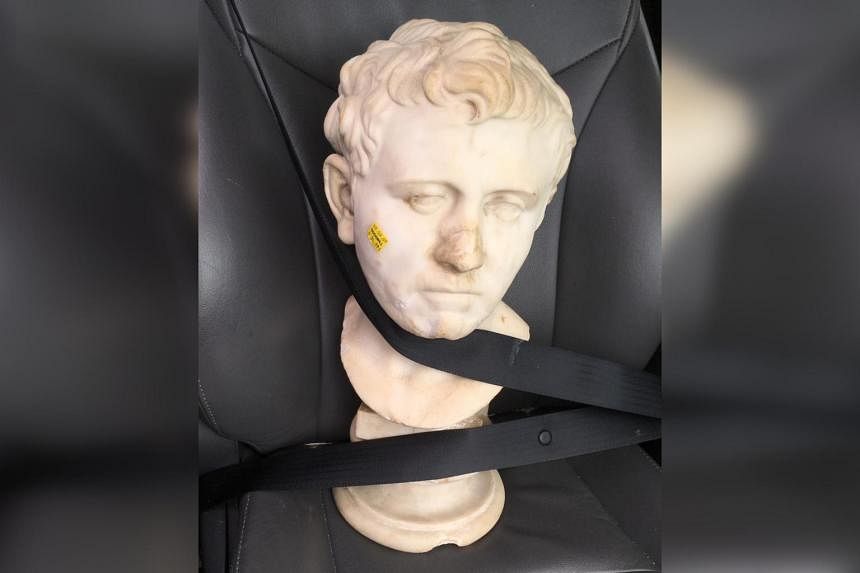AUSTIN, TEXAS (NYTIMES) - Ms Laura Young was browsing through a Goodwill store in Austin, Texas, in 2018 when she found a bust for sale. It was resting on the floor, under a table, and had a yellow price tag slapped on its cheek: US$34.99 (S$48.50).
She bought it.
Turns out, it was not just another heavy stone curio suitable for plonking in the garden.
It was an actual Roman bust from the late first century BC or early first century AD, which had been part of a Bavarian king's art collection from the 19th century until it was looted during World War II.
How it got to Texas remains a mystery.
But the most likely path suggests it was taken by a US soldier after the Bavarian king's villa in Germany was bombed by Allied forces.
This week, it went on display at the San Antonio Museum of Art, next to signage acknowledging Ms Young's role in its improbable, 2,000-year journey from ancient Rome to the Goodwill Boutique in Far West Boulevard.
Next year, it will be returned to the Bavarian government under an agreement with Ms Young that ended her own complex relationship with the ancient artefact, which she had kept on a credenza in her living room for more than three years.
She had named it "Dennis Reynolds", after a character from the comedy series It's Always Sunny In Philadelphia.
Like that vain and narcissistic cad, the almost 24kg marble bust was a "very difficult, cold, aloof, emotionless man that caused some problems for me", Ms Young said.
When Ms Young, a dealer of antique and vintage goods, first spotted the bust, as reported by public radio station KUT in Austin and The Art Newspaper, she knew it was probably valuable.
"I got it outside in the light," she said. "He had chips to the base. He had clear repairs. He looks old. I've been to museums. I've seen Roman portrait heads before."
She did a Google image search for "Roman bust" and realised "they look a lot like my guy".
After taking the bust home, strapped in a seat belt in the front seat of her car, she contacted two auction houses, Bonhams and Sotheby's, both of which confirmed that her hunch was right: The bust was from ancient Rome.
Ms Young was on vacation, celebrating her 40th birthday, when she got the e-mail from Bonhams. She wanted to return home immediately.
"He was at my house, alone," she said.
But subsequent research, authenticated by the Bavarian government, soon confirmed that Ms Young would not be able to sell the piece and fulfil the fantasy of anyone who has ever haunted Goodwill stores and yard sales for priceless treasures.
At some point before 1833, the bust had been acquired by Ludwig I, a Bavarian king, who displayed it in the courtyard of the Pompejanum, his replica of a Roman villa in Pompeii, in the Bavarian town of Aschaffenburg, according to Ms Young's attorney, Ms Leila A. Amineddoleh.
The Pompejanum was heavily damaged by Allied bombing in 1944 and 1945, and although some of its objects survived, others disappeared, Ms Amineddoleh said.

The looting of art by the Nazis has gained widespread attention. But because the bust ended up in Texas, it is likely that a US service member either stole it or traded for it after the war, Ms Amineddoleh said.
That meant that Ms Young was not the rightful owner because Germany had never sold the piece or abandoned the title to it, she added.
Ms Young said Goodwill was also unable to provide answers about the bust's origins.
"Immediately, I was like, okay, I cannot keep him and I also cannot sell him," Ms Young said. "It was extremely bittersweet, to say the least. But I have control only over what I can control, and art theft, looting during a war, is a war crime. I can't be a party to it."
So Ms Young struck an agreement to have the bust shipped back to Bavaria.
In exchange, she will receive only a "small finder's fee", which Ms Amineddoleh declined to disclose.
"We are very pleased that a piece of Bavarian history that we thought was lost has reappeared and will soon be able to return to its rightful location," Mr Bernd Schreiber, president of the Bavarian Administration of State-Owned Palaces, Gardens and Lakes, said in a statement released by the San Antonio Museum of Art.
The bust is believed to portray either a son of Pompey the Great, who was defeated in battle by Julius Caesar, or Nero Claudius Drusus Germanicus, a Roman commander whose forces once occupied German territory.

